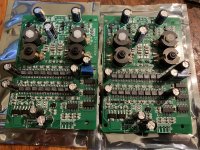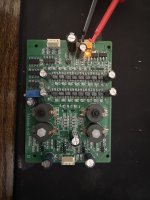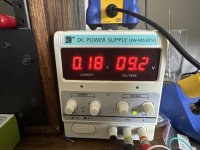@passive420 - apologies that the kits/soldering guide are not clear enough. Thanks for your feedback, we'll update the kits and/or guide to resolve the ambiguity.
On the logic ICs, U1,U19 are T86D and U20,U21 are 164D.
22R is used to select gain on U22,U23 yes.
I'll dig out the schematic and shoot it over to you.
On the logic ICs, U1,U19 are T86D and U20,U21 are 164D.
22R is used to select gain on U22,U23 yes.
I'll dig out the schematic and shoot it over to you.
@abraxalito Good man Richard , no worries I wondered if you realised. To be clear those Hex chips are the only confusing ones, I figured the rest out from package size and qty.
Many thanks 👍
Many thanks 👍
I get the same feeling of going into 'flow' from doing SMD soldering work, its a kind of meditative state of mind.
Thanks for the appreciative feedback, very encouraging! Let's hope the listening is at least as enjoyable as the build.
Thanks for the appreciative feedback, very encouraging! Let's hope the listening is at least as enjoyable as the build.
Finally got the PSU together, everything is working fine. The PSU board was designed by Prasi for my needs and uses DEXA discrete regs by NewClassD of Denmark.
I will be using Meldano's Muses volume control with this DAC in balanced mode, so a DAC / preamp eventually.
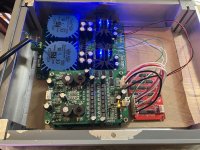
@abraxalito can I check - on the Amanero USB module, does MCLK or FSCLK correspond to LRCK on the DAC?
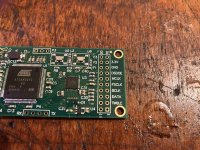
I will be using Meldano's Muses volume control with this DAC in balanced mode, so a DAC / preamp eventually.

@abraxalito can I check - on the Amanero USB module, does MCLK or FSCLK correspond to LRCK on the DAC?

I'm fairly sure it'll be FSCLK for LRCK. MCLK doesn't need to be connected.
@abraxalito - She sings my friend. What a lovely sounding DAC, very impressive indeed. It has real meat on it's bones, the lower frequencies are very full with noticeable punch, plenty of space and detail everywhere. It handles the decay of notes very well.
The output at 6db is very high so I may swap the resistor to 0db setting. It is without any attenuation yet just through Windows and Foobar volume controls.
My normal DAC is a Sabaj D5 with ESS Sabre 9038 chip, a very nice sounding DAC, the Sabre is a good all round DAC for sure. The Delta Sigma algorithms definitely shape the music in a pleasant way, initially it may have the edge on upper frequency details but I'm still re-learning the new sound. The Abbado certainly is more organic, less forced. After a few hours of listening to everything including films and podcasts, there is no fatigue at all.
Now there was a problem - initially I hooked both boards up with the splitter and listened to each board individually as single ended, just to check them before adding the muses and drilling holes in panels etc.
First board played music but I noticed some crackling from left speaker, so powered down, swapped output connection between DAC boards and listened and all was well, no crackling - so I swapped to the first board again and got a horrific loud distortion. I had a feeling that the splitter might be the issue, so tried both boards individually without the splitter and they both sound excellent.
I will hook the splitter up again later, possibly powering down and swapping the boards separately did something to the phase inversion. The real acid test is though my balanced headphone amp.
Oh - what do the trimmers do, and where do I measure?
The output at 6db is very high so I may swap the resistor to 0db setting. It is without any attenuation yet just through Windows and Foobar volume controls.
My normal DAC is a Sabaj D5 with ESS Sabre 9038 chip, a very nice sounding DAC, the Sabre is a good all round DAC for sure. The Delta Sigma algorithms definitely shape the music in a pleasant way, initially it may have the edge on upper frequency details but I'm still re-learning the new sound. The Abbado certainly is more organic, less forced. After a few hours of listening to everything including films and podcasts, there is no fatigue at all.
Now there was a problem - initially I hooked both boards up with the splitter and listened to each board individually as single ended, just to check them before adding the muses and drilling holes in panels etc.
First board played music but I noticed some crackling from left speaker, so powered down, swapped output connection between DAC boards and listened and all was well, no crackling - so I swapped to the first board again and got a horrific loud distortion. I had a feeling that the splitter might be the issue, so tried both boards individually without the splitter and they both sound excellent.
I will hook the splitter up again later, possibly powering down and swapping the boards separately did something to the phase inversion. The real acid test is though my balanced headphone amp.
Oh - what do the trimmers do, and where do I measure?
Last edited:
@passive420 I am visiting friends and family in UK at present (I think not a great distance away from you) so it'll be another week before I'm able to look deeper into the issue you are having with the splitter from your Amanero. Does it put out bitclock at 64fs (2.8MHz for 44.1k)?
Trimmers are so you can match levels L/R when running balanced with the splitter. To set up you need a test tone playing (I use 400Hz) and a DVM on ACV range. Use one or other of the trimmers to get a close match in the output levels. But if your splitter has somehow developed a malfunction that isn't going to be possible.
Thanks very much for the feedback on SQ. The 6dB setting is actually -6dB for using in balanced so 0dB will be 2X the output level. If -6dB still turns out to be too high level for you there are resistors that can be tweaked to lower it further but doing the calculations for those will have to wait until I'm back in China again.
Trimmers are so you can match levels L/R when running balanced with the splitter. To set up you need a test tone playing (I use 400Hz) and a DVM on ACV range. Use one or other of the trimmers to get a close match in the output levels. But if your splitter has somehow developed a malfunction that isn't going to be possible.
Thanks very much for the feedback on SQ. The 6dB setting is actually -6dB for using in balanced so 0dB will be 2X the output level. If -6dB still turns out to be too high level for you there are resistors that can be tweaked to lower it further but doing the calculations for those will have to wait until I'm back in China again.
Last edited:
Sorry for my ignorance, I am new here.
I am interested in this DAC. As I am currently upsampling my files with HQPlayer, is it possible to use this DAC with XMOS 384k card to play PCM 384k ?
I am interested in this DAC. As I am currently upsampling my files with HQPlayer, is it possible to use this DAC with XMOS 384k card to play PCM 384k ?
The TDA1545A DAC chips themselves can accept 8X oversampled data but that would need to be supplied with an I2S BCK set to 32fs (12.288MHz). The normal I2S BCK is 64fs and that's above the maximum BCK for the DAC chips.
If that's a bit technical for you the answer is 'its beyond chip spec' with your XMOS card at 384k, 'yes' at 192k. 384k has to be worth a try though so I'll look into getting a 384k capable USB card.
If that's a bit technical for you the answer is 'its beyond chip spec' with your XMOS card at 384k, 'yes' at 192k. 384k has to be worth a try though so I'll look into getting a 384k capable USB card.
Hello all, had a break but just got round to setting up my balanced Abbado 2 DAC again. ( @abraxalito, is this named after Claudio Abbado? )
Previously I encountered a problem with the phase splitter module causing a channel malfunction. I can reassure Richard that his kit works like a dream. My previous scare was clearly an issue with hot swapping or such, just being careless I guess.
Haven't messed with the output trimmers yet, everything sounds fine but will check. I will need to reduce the gain somewhat.
Richard - I re-read your previous post regarding setting gain, if you can post the formula or give values, certainly half the current output would be fine (Higher value resistors? ) The op-amp stage is impressive, is this your own design?
All is very good, nice full sound from this DAC, balanced into Dynalo head-amp then Focal Elears.
Start drilling holes tomorrow.
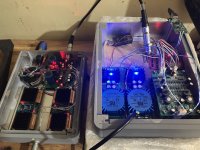
Previously I encountered a problem with the phase splitter module causing a channel malfunction. I can reassure Richard that his kit works like a dream. My previous scare was clearly an issue with hot swapping or such, just being careless I guess.
Haven't messed with the output trimmers yet, everything sounds fine but will check. I will need to reduce the gain somewhat.
Richard - I re-read your previous post regarding setting gain, if you can post the formula or give values, certainly half the current output would be fine (Higher value resistors? ) The op-amp stage is impressive, is this your own design?
All is very good, nice full sound from this DAC, balanced into Dynalo head-amp then Focal Elears.
Start drilling holes tomorrow.

Last edited:
Yes this DAC is named after Claudio Abbado, the conductor.
Here's the schematic portion of interest - the I/V and output stage of the DAC. I've highlighted the resistors which do I/V duty, they form a potential divider so its possible to adjust the output signal level downwards to any desired degree. The resistor values
shown there aren't those I fitted, I evened up the dissipation between the resistors somewhat rather than place almost none of the burden on R37 as here.

The total resistance needs to be 110R to match the LC filter. The function of R37 is for tweaking the total - (R34+R68) in parallel with R37 - to get a good match. The gain will be R68/(R34+R68).
An example - if you wanted 10dB attenuation (rather than 6dB provided stock) then R68 becomes 51R and R34, 110R.
If you're referring to the output stage, yes its one of my own design. The aim being not to modulate the power supply with the signal, it maintains a stable current draw.
Here's the schematic portion of interest - the I/V and output stage of the DAC. I've highlighted the resistors which do I/V duty, they form a potential divider so its possible to adjust the output signal level downwards to any desired degree. The resistor values
shown there aren't those I fitted, I evened up the dissipation between the resistors somewhat rather than place almost none of the burden on R37 as here.
The total resistance needs to be 110R to match the LC filter. The function of R37 is for tweaking the total - (R34+R68) in parallel with R37 - to get a good match. The gain will be R68/(R34+R68).
An example - if you wanted 10dB attenuation (rather than 6dB provided stock) then R68 becomes 51R and R34, 110R.
If you're referring to the output stage, yes its one of my own design. The aim being not to modulate the power supply with the signal, it maintains a stable current draw.
@abraxalito Thanks Richard, understood. I can go for -10db with what I have on hand I think.
Stuck some Wima 4.7uf on the outputs while the boards were out. Nice, like them better than the FCs. I may salvage some 100uf Os-cons to try on the DAC chip rails.
Some nights in testing to come
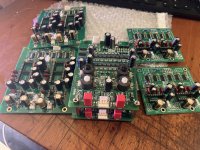
Stuck some Wima 4.7uf on the outputs while the boards were out. Nice, like them better than the FCs. I may salvage some 100uf Os-cons to try on the DAC chip rails.
Some nights in testing to come

Thanks @Vunce, got one of the PCM63 boards playing now single ended. Everything works well so far. just OPA604s on output and a plain metal film for I/V
Having got used to Abbado, first impressions are the PCM is brighter, accurate and clearer but less warmth and bass. The Abbado has definitely has a perceivable fullness which I liked. Got to give the PCM time to wake up, the I/V resistor will be improved and discrete op-amps should help. Shame I missed out on the CEN I/V.
Classic monolithic DACs using datasheet circuit vs State of the art, custom discrete design. Money is on the custom but well see 😉
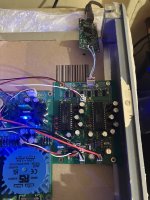
Having got used to Abbado, first impressions are the PCM is brighter, accurate and clearer but less warmth and bass. The Abbado has definitely has a perceivable fullness which I liked. Got to give the PCM time to wake up, the I/V resistor will be improved and discrete op-amps should help. Shame I missed out on the CEN I/V.
Classic monolithic DACs using datasheet circuit vs State of the art, custom discrete design. Money is on the custom but well see 😉

This should be a really interesting comparison. By my calculations the PCM63's noise is limited by the OPA604 giving about 113dB SNR in the higher frequencies but the noise gets 6dB worse at 20Hz due to the characteristics of OPA604's input stage JFETs.
As a comparison SNR for a single TDA1545 is 98dB, you effectively have 32 paralleled by running balanced so the noisefloor of the DAC array is 15dB (2^2.5) better than that, giving the same 113dB. The difference is - Miro's DAC is limited by the opamps, Abbado is limited by the DAC chips themselves.
Looking forward to how it pans out.😎
As a comparison SNR for a single TDA1545 is 98dB, you effectively have 32 paralleled by running balanced so the noisefloor of the DAC array is 15dB (2^2.5) better than that, giving the same 113dB. The difference is - Miro's DAC is limited by the opamps, Abbado is limited by the DAC chips themselves.
Looking forward to how it pans out.😎
Just spamming the thread I guess, but had the chance to swap out the PCM63 for the Abbado again. Good to have it back.
Took the opportunity to try some different caps - SEP OS-cons on the DAC chip rails and some fancy Pana audio caps for the output analogue rails. All sounds very nice. To be fair Richards component choice is good enough. Changing the output FC's for film worked well, Bi-polar might be good here as they are in series with output.
Without caps one DAC board had around 19mV DC but the other was around 40mV, so the caps are needed.
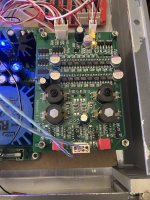
Got a pair of CEN I/V boards to try with Miro's DACs, in the picture below are the excellent Sjostrom Diamond buffer boards which may also work well. Need to reconfigure the PSU to run all this.
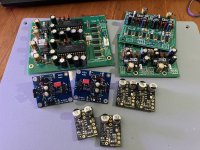
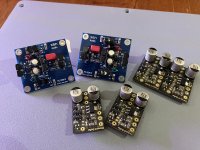
Miro's DACs turned out to be expensive to build, I hope I can get the best out of them, but the the Abbado is already hard to beat. For the money it's a hell of a good DAC.
Fair play lad 😉
Took the opportunity to try some different caps - SEP OS-cons on the DAC chip rails and some fancy Pana audio caps for the output analogue rails. All sounds very nice. To be fair Richards component choice is good enough. Changing the output FC's for film worked well, Bi-polar might be good here as they are in series with output.
Without caps one DAC board had around 19mV DC but the other was around 40mV, so the caps are needed.

Got a pair of CEN I/V boards to try with Miro's DACs, in the picture below are the excellent Sjostrom Diamond buffer boards which may also work well. Need to reconfigure the PSU to run all this.


Miro's DACs turned out to be expensive to build, I hope I can get the best out of them, but the the Abbado is already hard to beat. For the money it's a hell of a good DAC.
Fair play lad 😉
- Home
- Vendor's Bazaar
- Abbado II NOS DAC kits
